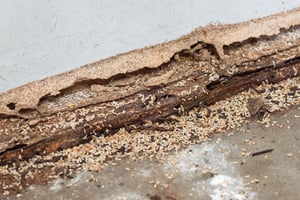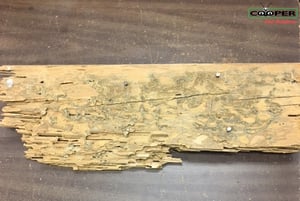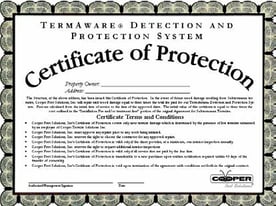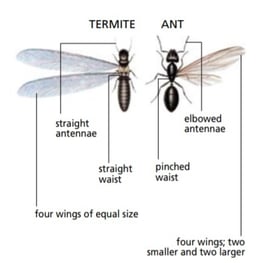How to Get Rid of Termites
Termite detection and active termite elimination are necessary evils that homeowners face when it comes to these wood destroying insects. Termite infestations can be stressful and confusing with the amount of tips, tricks, and advice that's found across the internet. Cooper is here to make it simple for you to do research about termites from a trusted source. Do you have termites in your home? Or maybe you want to learn more about how termite services work. Our library of termite information will answer your questions.
Termite Library Shortcuts
How To Get Rid of Active Termites
How Can I Protect My Home From Termites?
The Difference Between Flying Ants and Termites
Does Cooper provide home inspection reports for real estate transactions?
Termites are a common occurrence in nature, and are constantly in search of additional food sources. Worker termites travel underground looking for fallen trees, decaying wood, plant debris, and other cellulose materials to consume and bring back to the colony. It is not uncommon to find termites in mulch or a nearby wood pile around your home. Improper moisture control, leaf litter, and direct wood-to-soil contact are all prime conditions that can promote termite activity on your property, often times within close proximity to your home. While foraging, worker termites will enter cracks in the foundation of your home, ultimately leading them to the wood within the structure.
Eastern Subterranean termites are native to New Jersey and Pennsylvania. Eastern Subterranean termite symptoms can be seen in your home if: You see swarming termites in your home (this usually occurs in the spring)
- You see dead termites. Termite swarms happen very quickly in the springtime.
- Since termites eat wood from the inside, you may see Hollowed wood.
- Mud tunnels. Termites build elaborate tunneling systems beneath the ground.
- Structural weakness which includes a “soft feeling” floor or ceiling.
Cooper designed the TermAware™ Program to be the most comprehensive termite service that the industry has to offer. Our program addressed the limitations that are posed when either a liquid treatment or a baiting only system are used as the only means of control.

Cooper’s Termite Program includes:
- An initial service to install our TermAware™ monitors (10 feet apart)
- Four quarterly visits from one of our termite experts who will provide a thorough inspection of the termite monitors and your home’s exterior during each visit.
- If Cooper detects Termites in a station or the house during one of our regular inspections, we will treat the problem as necessary and return monthly until the problem has been eliminated.
- TermAware™ includes a transferable Certificate of Protection for as long as your own your home.
TermAware™ incorporates the latest technology in termite detection with proven treatment products and methods to provide you an unparalleled level of control and peace of mind. The combination of liquid treatment and preventative monitoring will eliminate the threats that exist today and identify the threats of tomorrow.
How To Get Rid of Active Termites
Cooper's strategy for active termite elimination combines monitoring and treatment. Sentricon® Always Active works through monitoring systems in the ground around your home; however these monitoring stations always contain a small amount of bait to kill any termite colonies

that may find their way onto your property. Sentricon® Always Active stations are monitored using a scanner which connects to a computer and provides accurate results in less time. The service consists of two inspections
a year for at least a two year period to make sure that termites have not been active on your property. Sentricon® will kill termites before they can reach your home and do any damage, leaving you worry-free about the cost of additional services or repairs.
- Liquid termite treatments will break down over time regardless of who does the treatment and what material is used. Your house will become vulnerable to future termites advances by the same or different termite colonies.
- It is impossible to apply a perfect “barrier” around your home where every square inch of your foundation is covered. There will always be small gaps in a treatment that may allow termites into the structure unharmed.
- It is probable that many termite colonies are living near the foundation of your home. Termites found in monitoring devices outside do not always attack a house.
- Termite Damage is most often hidden within walls and may not be found during an interior inspection by the most skilled technicians.
- Baiting programs are dependent upon termites finding the bait stations and then consuming the bait. Research has shown that termites randomly forage for food and it can sometimes take a long time for termites to locate and begin feeding on bait stations. Until they do, they can continue to damage your house. This is the greatest limitation to baiting programs that are not supplemented with other treatment technologies.
- The optimal detection of termites is a monitoring device every ten feet. Based upon research studies conducted by Dow AgroSciences, monitoring stations places only at corners or at intervals greater than ten feet apart are less likely to be discovered by termites foraging in the soil.
How Can I Protect My Home From Termites?
Depending on your unique situation, there are several steps you can take to prevent or treat your home for termites.
Proactive Monitoring
The TermAware™ monitoring program, which is exclusive to Cooper Pest Solutions, is a termite monitoring program that is designed to keep termites from initially infesting and damaging your home. After TermAware™ monitors are installed on your property, skilled technicians will inspect every monitor each spring, summer and fall. You will then receive written inspection reports with each visit. In the winter, technicians will inspect the interior of your home for any signs that termites have made it past the sensors undetected. If termite activity is determined, Cooper will respond immediately with appropriate treatment. With a proactive TermAware™ service, you will receive coverage for any future termite problems once Cooper has ascertained that there are no pre-existing conditions.
Reactive Services
- Baiting
If you currently have termite activity, you have a few different service options on how to address the infestation. The Sentricon® baiting station service is a great option for properties that cannot, or do not want to use the traditional liquid termite treatments due to various restrictions.
- Liquid Treatments
Your home may qualify to receive the traditional liquid termite treatment. This treatment entails having our skilled technicians trench and rod the ground around the exterior of your home, as well as drill through concrete that is against the home. Termiticide will then be distributed in the ground around the perimeter of the home and adjacent to the foundation.
- Continuous Monitoring
Ongoing monitoring is key for detecting and preventing future infestations with termites. You can use either Sentricon® Monitoring service or continuation of Cooper Pest Solutions’ exclusive proactive TermAware™ program.
Our skilled technicians understand the importance of monitors when it comes to termites. By utilizing current research from leading industry experts, our technicians have the knowledge of what the most successful treatment and preventative protocols are for termites.

Exclusively through the TermAware™ program, you can receive a TermAware™ Certificate of Protection valid six months after initial treatment. The protection is valid as long as the TermAware™ monitoring program is in effect.
The TermAware™ Certificate of Protection serves as insurance against termite damage that may occur from a new termite infestation and will cover necessary home repairs.
The Difference Between Flying Ants and Termites
There are four key differences between flying ants and termites. Flying Ants have a pinched waist and elbowed antennae, which often has them being mistaken for termites.

They also have two sets of wings, which one set is larger than the second. Termites, however, have a straight antennae and their wing sets are of equal length. They also have more of a tubular, thick waist. Another major difference is that termites lose their wings readily, shedding them onto the ground, whereas the wings on ants typically remain attached to the insect’s body.
The table below illustrates the three significant differences among the two pests.
|
Flying Ants |
Termites |
|
Elbowed Antennae |
Antennae Not Elbowed |
|
Two Pairs of Wings of Unequal Length |
Two Pairs of Wings of Equal Length |
|
Thin Waist |
Thick Waist |
|
Wings Do Not Readily Fall Off |
Wings fall off easily & will be seen on the ground |
Does Cooper provide home inspection reports for real estate transactions?
Unless you are already enrolled in our termite monitoring program, unfortunately, the answer is no. The reason we do not provide this service is that we believe that to successfully inspect for termites, we need to monitor for termites that are not visible, or that may be lurking around your home. To do this effectively, we need to install our monitoring system for a minimum of 4 warm months before we can say that there is no pre-existing termite condition. However, if the seller is willing to provide the buyer with a 4-month window during the early spring and summer to allow us to monitor for termites, then we will gladly perform this service. The problem is that in most cases the real estate transaction does not allow for the buyer to monitor the property for an extended period of time and sellers definitely don’t want us to find termites on their property which could result in them being liable for repairs to the home and potentially having the buyer back out of the deal.


